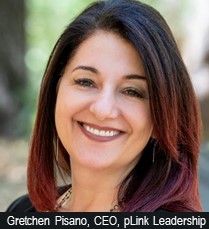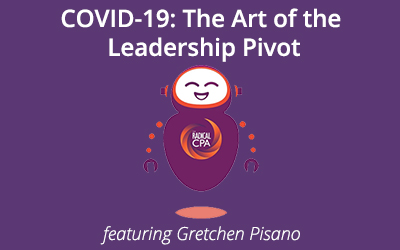How are you all doing out there? It seems crazy right now, but as the world keeps changing, we have no choice but to continue keeping up. Part of understanding how to do that is knowing how to pivot.
Recently I was speaking with Gretchen Pisano, CEO of pLink Leadership. Social media listeners and blog readers are familiar with her by now, as she continues to be an amazing source of information and inspiration. In my last Let’s Get Radical … Live session, Gretchen and I talked about the leadership pivot.

What does that mean? Well, let’s back up for just a second. CPAs basically have four seasons now: tax season has moved into loan season, which will move into extension season, and I guess finally planning season, right? Maybe even an amended tax season because we’re certainly going to be amending lots of tax returns this year. Not to mention, “loan season†is full of confusion and systems aren’t’ established yet. The rules are changing daily and the complexity is causing frustrating and deep anxiety in all ranks of CPAs. I totally get it, and I’m right there with you. Â
Back to the leadership pivot. In such a chaotic, anxiety-ridden environment, we need to embrace the leadership situation we now find ourselves in. We didn’t plan for this, and we didn’t know what we were supposed to do, but damn it, we will figure it out and come out stronger!
Embrace the Chaos …
Gretchen began by reminding listeners that change is inevitable. And there might be a predictable pattern to change, but there’s no going back. Right now, the change we’re in, we’re never going back to the same starting place. We’re moving through an evolution and the new normal is nonexistent at this point. How can we possibly embrace this sort of disruption as we’re already living in a state of exhaustion?Â
The first thing she reminded us is that if we are doing the exact same things to cope, or to lead, whatever, in this new environment, then we’re not adapting. Period. The word “adapt†means to become better suited to your environment. The question isn’t, “How long do I wait until things go back to normal?†We have to notice that the environment in which we now operate has changed, which means that we need to change, too.
Instead of resisting the chaos, lean into it. Gretchen mentioned a visualization of learning how to hold something in an open hand, not a closed fist. The idea of holding onto the current environment versus recognizing how it is today and how it might be different tomorrow, without the need to make the environment a certain way.
Most people think in the past, in a very static environment. This is why our clients come to us with an expectation of certainty, that we know the answers. The problem is that the answers change almost too quickly to keep up. In these types of conversations with your clients, if you feel like they’re getting frustrated or not getting what they want from you, remember that above all they are seeking assurance and guidance. And you can give that to them, right? Recall from previous Let’s Get Radical … Live sessions, we don’t tell clients we can fix it, because we can’t. But we guide them toward the answer that perhaps they already know, while pointing out our assessment of their current situation, risk profile, and whether they want to take that risk or not.
HOWEVER, do not get lost in the technical subject matter expertise here. Your bedside manner, as financial doctors, depends upon letting go of the armor of technical jargon and just being there, as a human, for your clients. Pay attention to them, really demonstrate that you know who they are, what their financial situation is, and that you have their best interests at heart. And then take that into consideration every time you give advice or answer a question.
Be honest, be realistic, but with emotional concern. Being an empathetic leader is being able to make an assessment of where your client is by asking the right questions and communicating with intentional emotion. It’s not the touchy feely stuff some people think of when they hear ‘emotions.’ It’s intelligence; emotional intelligence. Your clients need that from you right now. Emotional intelligence during a time of crisis will build loyalty, from your clients and employees.
Communicate Often, and With Emotion …
The next point Gretchen made was about communication. We can’t communicate enough right now. Even if it’s an email to say ‘hey, we know the world is changing and we’re in it with you.’ Or, ‘this is where things are today.’ Daily updates. We may not have the time to be on the phone with everyone all day, but we can send regular emails to let clients know we’re thinking of them and looking out for them. Â
Here’s a tip: consider open office hours. Have a designated time each day where clients can hop in a Zoom meeting, knowing it’s a group conversation, and just talk. Or, you could schedule a daily or weekly webcast. We’re already doing that here, but not all firms are. Open up your calendar so clients can make their own appointments in 15- or 30-minute blocks. Maybe you even set up a temporary blog where the managing partner writes something every day. Doesn’t have to be long. But it’s something to maintain the connection during a time of crisis.
You also want to think about delegating these conversations. If there are more clients than you have time to talk to, designate members of your team to reach out to the clients. This will also push your team to get out of their own comfort zone and initiate human interaction.
Because people are anxious and uncertain, they have a strong bias to action. They don’t even know if they’re solving the right problem. They’re just doing something. And the minute you start doing the work, you get attached to the product. But it turns out, that work was unnecessary. Think about some of those loan applications where the rules changed daily. The form changed, or the regulation changed. And everything you just worked on can’t be used now. That’s an emotional hit. And it can cause a meltdown in times like this.
The important thing is to be able to recognize that meltdown when it’s happening. Acknowledge it, and then move on. Get comfortable in the chaos. Get comfortable with living in this uncomfortableness.
The key is figuring out how we’re gonna work in today, because this is what we have right now when it changes tomorrow. Gretchen had a saying, “Do the work. Undo the work.†All we can do is make decisions based on our best judgment and keep moving, which is hard.
The Way Forward …
For a long time, our work has been judged from a professional point of view. We are now moving from a rules-based profession to a judgment-based profession. Before COVID-19, if you did something incorrectly, you took a hit to your competence. But now, when you take action based on the most current counsel and it turns out to be not what you needed to do, you can’t measure that with the same measuring stick. It’s not a measure of competence or incompetence. It’s actually a measure of agility.
How quickly and how willing are you able to respond to market conditions and market asks? How much emotional resilience and psychological resilience do you have? Can you bounce back quickly from work that needs undone? You have a choice in that moment to either get incredibly frustrated and allow that frustration to permeate throughout your team. Or, you can say, we just shifted. This is what the pivot is.
With the leadership pivot, you have one foot firmly planted on the ground, where your center of gravity is. You can pivot in any direction, take any trajectory you need to when you see the opportunity. But you’re not totally committing your psychological and emotional energy to any one direction yet.
The center of gravity in the leadership pivot is who you want to be as a CPA; what you want your firm to be known as; how you want your leadership to be looked at 18 months from now with a historical perspective. How did you show up for your employees? Your clients? That’s what you ground yourself in.
The outcome is not whether you filed the paperwork or not. You’re placing your value in your agility; how easily you’re able to pivot with your clients. Maintain your composure and compartmentalize those negative feelings, because this is a wild ride.  Â
The pivot is kind of the end result, the deliverable, that is typically what CPAs are used to. Instead of ‘here’s your tax return, here’s your loan document,’ it’s ‘we’re here with you and we’ll help you through this.’
There’s not one magic right answer. Nobody knows for sure how the future will play out. But as you think about getting there, it’s important to maintain your resilience so you don’t deplete yourself, your employees, or your clients in the process.
And what we’re talking about here is intellectual, physical, and emotional resilience. Keeping your center of gravity so you have a pivot foot and you’re not lunging all over the place, over-committing people and resources.
We’re also learning how to hold things with an open hand, versus a closed fist. We have to have a bit of a sense of humor around what’s going on, from a technical point of view, certainly not a health point of view, so we can more easily adapt. For us, as CPAs, it’s helpful to think of all of this as a pilot. It’s an experiment. The outcomes and the measure of an experiment are what did you learn?
Ultimately, this is a marathon, not a sprint. These scenes are going to continue to evolve. During this crisis, we’re going to learn a lot in the process. We’re going to make mistakes. And we’ll do it together.
Listen to the full recording below.

0 Comments